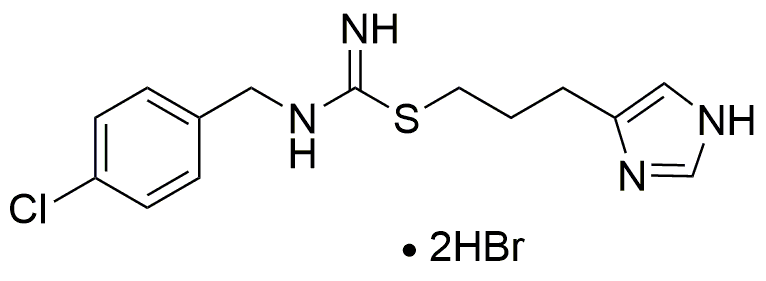Clobenpropit dihydrobromide is widely utilized in research focused on:
- Pharmaceutical Development: This compound plays a crucial role in the development of new medications, particularly in the field of antihistamines, where it helps in understanding receptor interactions and drug efficacy.
- Neuroscience Research: It is used to study the central nervous system, particularly in exploring the mechanisms of neurotransmitter release and receptor activation, aiding in the development of treatments for neurological disorders.
- Allergy and Immunology Studies: Researchers leverage its properties to investigate allergic reactions and immune responses, contributing to the formulation of better allergy medications.
- Drug Interaction Studies: This compound is valuable in assessing how different drugs interact within the body, which is essential for ensuring safety and efficacy in combination therapies.
- Biochemical Assays: Clobenpropit dihydrobromide is employed in various biochemical assays to measure the activity of specific enzymes or receptors, providing insights that can lead to innovative therapeutic strategies.
Informations générales
Propriétés
Sécurité et réglementation
Applications
Clobenpropit dihydrobromide is widely utilized in research focused on:
- Pharmaceutical Development: This compound plays a crucial role in the development of new medications, particularly in the field of antihistamines, where it helps in understanding receptor interactions and drug efficacy.
- Neuroscience Research: It is used to study the central nervous system, particularly in exploring the mechanisms of neurotransmitter release and receptor activation, aiding in the development of treatments for neurological disorders.
- Allergy and Immunology Studies: Researchers leverage its properties to investigate allergic reactions and immune responses, contributing to the formulation of better allergy medications.
- Drug Interaction Studies: This compound is valuable in assessing how different drugs interact within the body, which is essential for ensuring safety and efficacy in combination therapies.
- Biochemical Assays: Clobenpropit dihydrobromide is employed in various biochemical assays to measure the activity of specific enzymes or receptors, providing insights that can lead to innovative therapeutic strategies.
Documents
Fiches de données de sécurité (FDS)
La FDS fournit des informations de sécurité complètes sur la manipulation, le stockage et l’élimination du produit.
Spécifications du produit (PS)
Le PS fournit une description complète des propriétés du produit, notamment sa composition chimique, son état physique, sa pureté et les exigences de stockage. Il détaille également les plages de qualité acceptables et les applications prévues du produit.
Certificats d'analyse (COA)
Recherchez des certificats d'analyse (COA) en saisissant le numéro de lot du produit. Les numéros de lot et de lot se trouvent sur l'étiquette d'un produit, après les mots « Lot » ou « Lot de fabrication ».
Numéro de catalogue
Numéro de lot/série
Certificats d'origine (COO)
Ce certificat d'exploitation confirme le pays dans lequel le produit a été fabriqué, et détaille également les matériaux et composants utilisés et s'il est issu de sources naturelles, synthétiques ou autres sources spécifiques. Ce certificat peut être requis pour les douanes, le commerce et la conformité réglementaire.
Numéro de catalogue
Numéro de lot/série
Fiches de données de sécurité (FDS)
La FDS fournit des informations de sécurité complètes sur la manipulation, le stockage et l’élimination du produit.
DownloadSpécifications du produit (PS)
Le PS fournit une description complète des propriétés du produit, notamment sa composition chimique, son état physique, sa pureté et les exigences de stockage. Il détaille également les plages de qualité acceptables et les applications prévues du produit.
DownloadCertificats d'analyse (COA)
Recherchez des certificats d'analyse (COA) en saisissant le numéro de lot du produit. Les numéros de lot et de lot se trouvent sur l'étiquette d'un produit, après les mots « Lot » ou « Lot de fabrication ».
Numéro de catalogue
Numéro de lot/série
Certificats d'origine (COO)
Ce certificat d'exploitation confirme le pays dans lequel le produit a été fabriqué, et détaille également les matériaux et composants utilisés et s'il est issu de sources naturelles, synthétiques ou autres sources spécifiques. Ce certificat peut être requis pour les douanes, le commerce et la conformité réglementaire.

